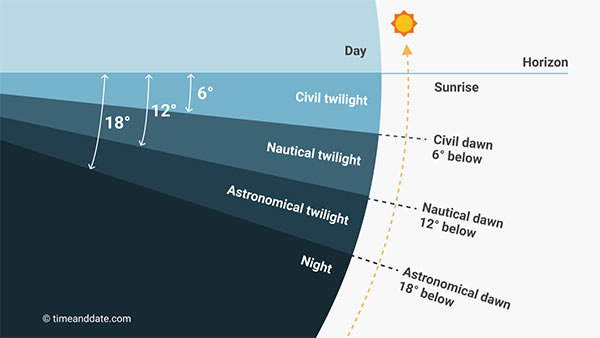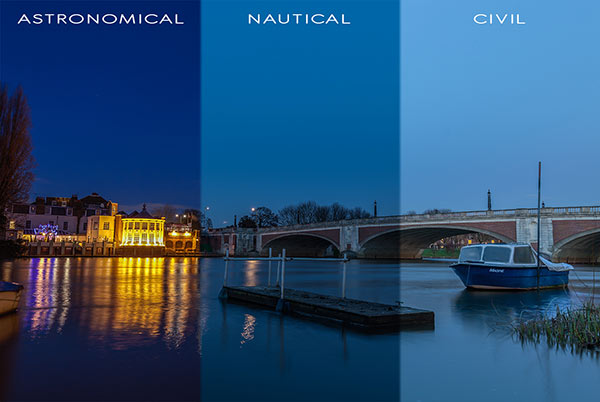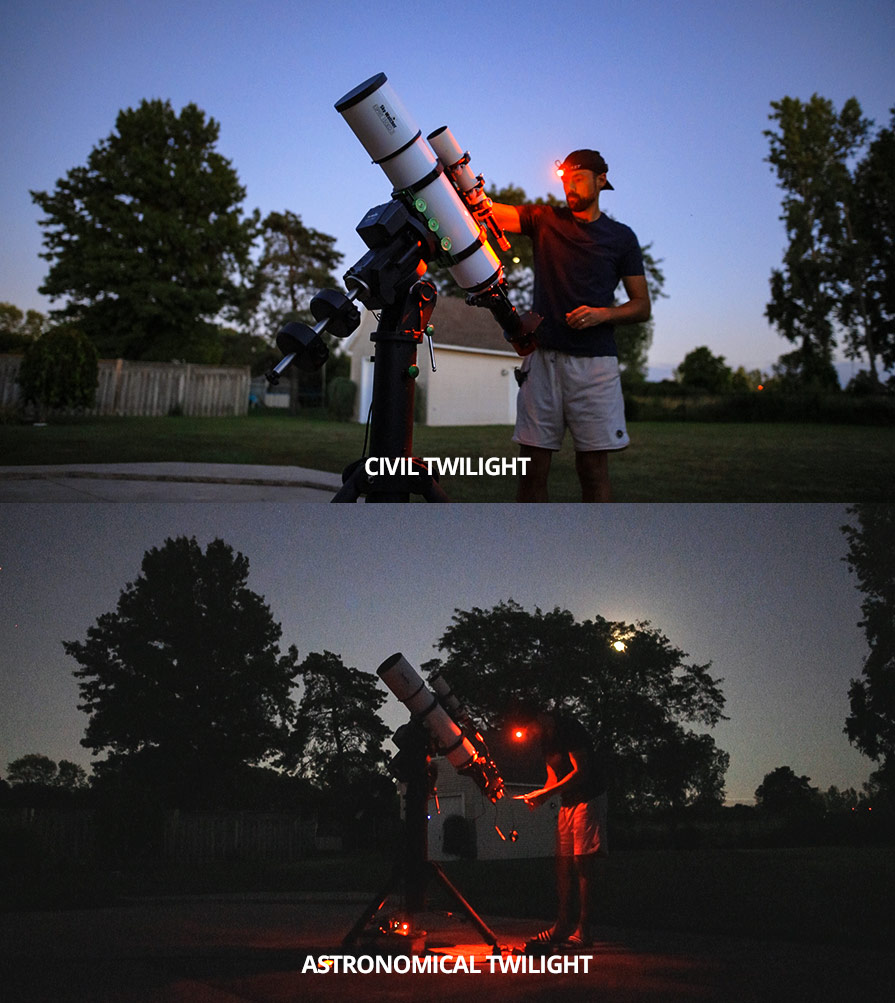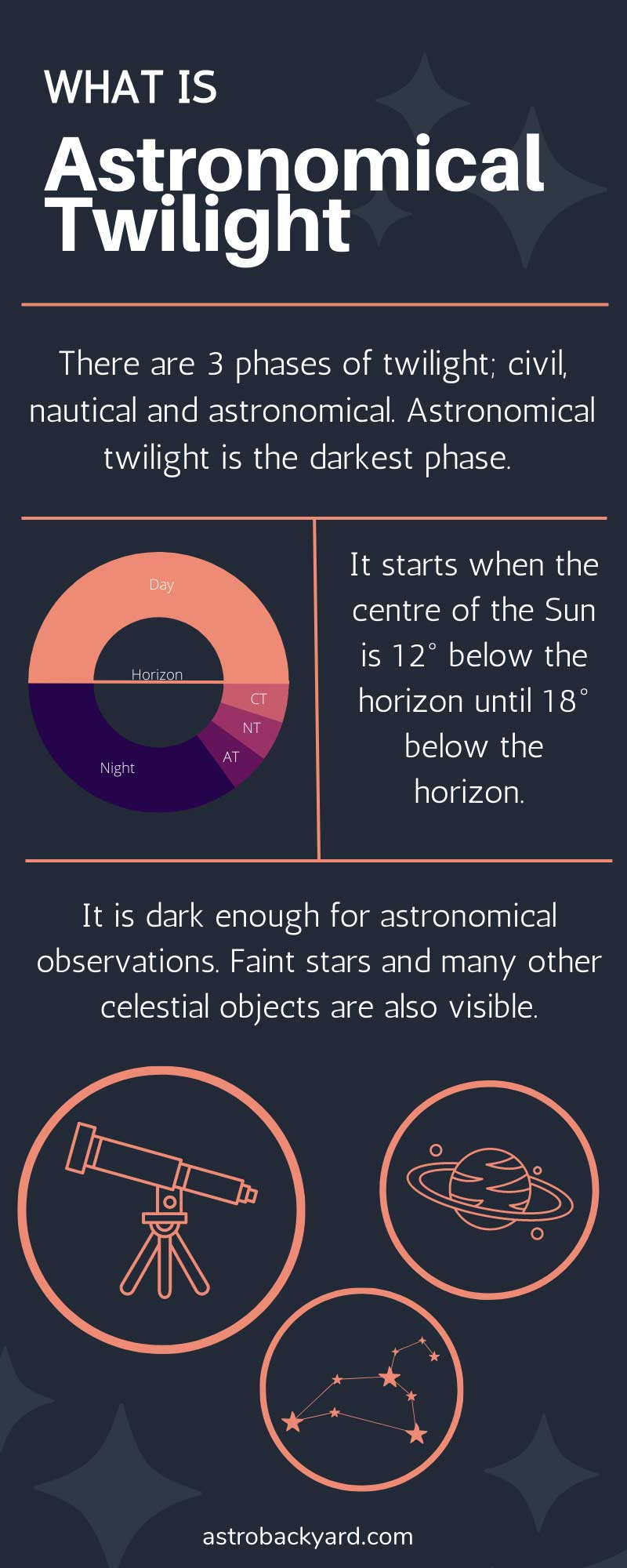What is Astronomical Twilight?
Twilight refers to the period of time when the sun is below the horizon where scattered sunlight illuminates the atmosphere.
The lower the sunlight is below the horizon, the darker the twilight will be. Astronomical twilight is the darkest of the three twilight phases. It is also the last phase of twilight during sunset and the earliest stage during sunrise.
Source: timeanddate.com
Twilight Phases
There are three phases of twilight, each one identifying a different level (or amount) of sunlight present in the atmosphere. Each phase is defined by the angle of the ‘geometric centre’ of the sun in relation to the horizon.
Each twilight phase happens twice a day, in the early morning (before sunrise) and late evening (after sunset). For this purpose, let’s look at the phases of twilight as they happen after sunset.
Three Phases of Twilight:
- Civil twilight
- Nautical twilight
- Astronomical twilight
Three Twilight Phases | Source: Leigh Cousins
Civil Twilight
Civil twilight happens the moment the sun dips below the horizon until the center of the sun is six degrees below the horizon.
During this time, sunlight clearly defines the horizon and artificial light is typically not needed. The brightest stars and planets (such as Venus) can also be seen during this time.
Nautical Twilight
Nautical twilight is the next phase of twilight that starts when civil twilight ends. This is when the center of the sun is 6 degrees below the horizon until it reaches 12 degrees below the horizon.
During this time, terrestrial objects are visible but artificial light is typically needed for outdoor activities. Most bright stars can be seen and the horizon is still visible. This is particularly important for sailors who use the stars and horizon for navigation.
Astronomical Twilight
Astronomical twilight is the darkest twilight phase. It starts when the center of the sun is 12 degrees below the horizon until 18 degrees below the horizon. After 18 degrees, it is considered ‘night’ or ‘dark’. It may be difficult for some to distinguish astronomical twilight from night. But unlike the other phases, astronomers are able to see fainter stars during this phase.
Faint stars and other celestial objects are visible and it is dark enough for astronomical observations. Astronomers may need to wait for truly dark skies for objects like galaxies and nebulae depending on the amount of light pollution present.
Light pollution, specifically skyglow, will affect your ability to distinguish astronomical twilight from night as well as your opportunity to view anything but the brightest stars in the night sky.
What does Astronomical Twilight Look Like?
Astronomical twilight looks like it nighttime, with an almost imperceptible bit of added light. The average person would probably consider the astronomical twilight phase to be full-on nighttime.
Amateur astronomers, however, will notice that faint deep-sky objects such as star clusters are not as apparent as they would be at night. The best way to distinguish between astronomical twilight and ‘dark” is by comparing the visibility of fainter stars in the sky.
During nights of a full moon, it is much harder to distinguish the period of astronomical twilight because the bright moonlight washes out the faint stars and deep-sky objects in the night sky.
Duration of Astronomical Twilight
Astronomical twilight varies by location and will depend on your proximity to the equator and the time of year. How
A phase could be as short as 24 minutes (near the equator) or several weeks (near the poles). At mid-latitudes, it can last anywhere from a half hour (fall to spring months) to one hour (summer months).
For mid-latitudes, the Sun is at a lower angle with the horizon, so twilight lasts longer than in places close to the Equator, with relatively short twilight phases.
At high latitudes (around the summer solstice), the Sun’s path does not reach below 18° below the horizon, so twilight can last all night (from sunset to sunrise). By contrast, within the Arctic Circle, the Sun does not set in the summer, so there is no twilight at that time of year.
Keep in mind that, at the same location, it can take up to 1.5 hours to reach astronomical twilight after civil twilight, so plan your visual and/or astrophotography accordingly.
Twilight and Astrophotography
Though the sky is not totally dark during the astronomical twilight phase, it is often a good time for astrophotographers to prepare for their imaging session.
You can do this by:
- Polar aligning your telescope
- Focusing your camera on the brightest stars,
- Getting your eyes ‘dark adapted’
- Slewing to your target



